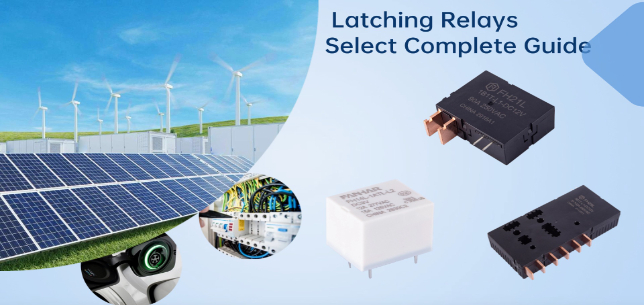
Latching relays are the ideal solution for low-power or high-temperature applications where power consumption or coil self-heating make it impossible to apply. They function on short voltage pulses instead of applying a continuous voltage to the coil. Latching relays change. When a coil voltage is provided to a latching relay, it changes its contact position and remains there even after the voltage is removed. (The term "SET" is commonly used to activate a latching relay). To reset a latching relay, provide another voltage pulse.
It is critical to obtain a thorough grasp of magnetic retention relays before making a decision. The magnetically held relay is a unique sort of electrical switching mechanism that continues to operate even when the power supply is turned off. The device's fundamental operating concept is based on the electromagnetic field effect, and it has several notable qualities.
The device is characterised by high energy efficiency. In contrast to conventional relays, which require a constant current supply to maintain their switching state, magnetic relays are capable of remaining in the switching state without such a supply. This characteristic renders them optimal for applications wherein a state must be maintained for an extended period, particularly in the modern era when environmental preservation and energy conservation are becoming increasingly crucial.
The aforementioned characteristics contribute to the high reliability of the aforementioned device. It is generally accepted that magnetic relays are more reliable than their traditional mechanical counterparts. Such devices are capable of successfully preventing faults and are less vulnerable to external disruptions, thereby increasing system stability.
The aforementioned device is characterised by a long operational lifespan. The service life of magnetically held relays is longer than that of traditional relays due to the reduced frequency of mechanical movement, which in turn results in diminished wear and tear. In circumstances where prolonged operation is required, this attribute is of significant consequence.
The ability to switch rapidly is a further advantage of latching relays, which are ideal for systems requiring a quick response time.
The magnetic type:
Magnetic latching relays utilise permanent magnets to maintain their position once activated. Such devices may be constructed with either a single or two coils. A permanent magnet is used to ensure that the armature is retained in the coil-pressed position.
The mechanical type: Mechanical latching relays use a ratchet and pawl mechanism to ensure the contacts remain in their designated positions, unlike magnetic latching relays which employ permanent magnets to maintain the position of the armature once activated. The relay is set or reset by moving the pawl and sending a pulse to the coil.
Electronic type: Unlike typical electromechanical relays, these use semiconductor devices to accomplish the latching function without moving parts. They maintain their condition by electronic circuitry rather than a mechanical mechanism.
Physical dimensions constitute a significant factor in the selection of a latching relay. The requisite dimensions of a relay are contingent upon the specific application. The following points merit particular attention:
The space required for installation is a crucial factor to be taken into account. The initial stage in the selection process is to ascertain whether the dimensions of the relay are compatible with the available installation space. In the event of limited spatial availability, it is recommended to select a compact relay with a malleable design.
Have you ever wondered what the term "form factor" actually means? It's the three-dimensional configuration of a device's external structure. And in specific applications, the form factor of the relay may be a crucial element, particularly in the context of electronic equipment where aesthetic considerations are of paramount importance. In such instances, it is recommended that a relay with a form factor that is consistent with the overall design of the device be selected.
It is of paramount importance to consider the thermal performance of a relay when making a selection. Larger relays dissipate more heat, which is important in high-power applications. This improves the relay's stability and service life.
It is recommended that, when selecting a product, the size specifications are checked and matched with the actual installation environment.
The number of contacts of a latching relay has a direct impact on its control capability and flexibility. Usually, the number of contacts of the relay can be divided into the following categories:
Single-contact:
suitable for basic control needs, relatively simple and inexpensive. Generally used for simple switching control occasions.
Dual-contact:
Provides more flexible control options and is suitable for a wide range of application scenarios. Dual-contact relays are capable of multiple functions and are suitable for systems requiring complex control.
Multi-Contact:
Typically found in industrial automation equipment, and ideal for complicated control systems. These relays may perform numerous control functions on a single device, resulting in greater system integration and flexibility.
In selecting a relay, it is essential to ascertain the requisite number of connections based on the control system's design criteria. This ensures that the relay is capable of meeting the operational requirements.
It is crucial to consider voltage and frequency when selecting latching relays, as they directly influence the relay's normal operation and safety. Prior to selection, the following elements must be addressed:
Operating frequency: For applications that demand high frequency switching, a suitable relay must be used to assure performance. Different relays have varying abilities to adjust to the frequency, which should be considered while picking.
It's very important to choose the correct latching relay in order to ensure the efficiency and dependability of an electrical system. It is essential to understand the fundamental characteristics, distinct kinds, physical dimensions, number of contacts, and crucial elements such as voltage and frequency of a latching relay in order to make an informed and confident decision.
This advice will prove a useful reference when purchasing a magnetic retention relay. It will help the reader identify the device that best meets their requirements, thereby improving the performance and stability of their systems. Should further clarification be required or additional assistance be sought, consult the relevant specialists or suppliers.